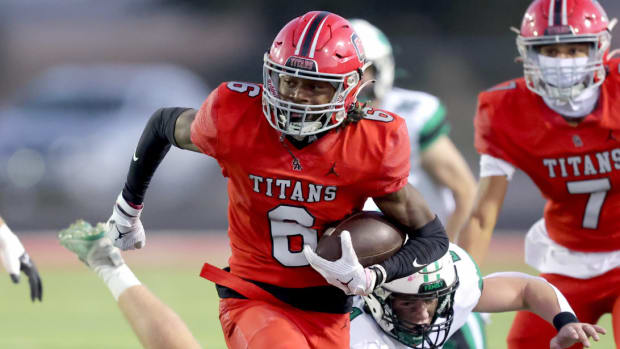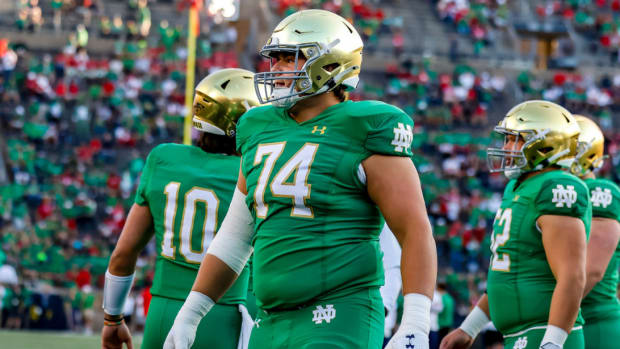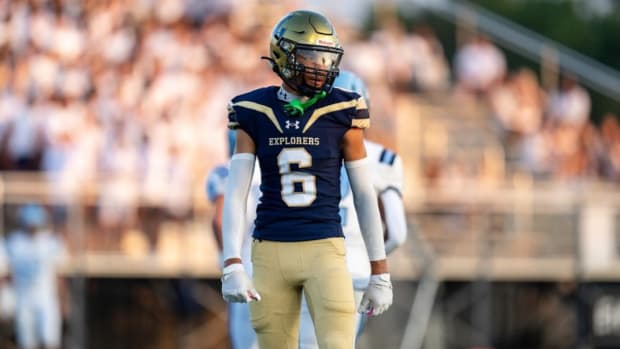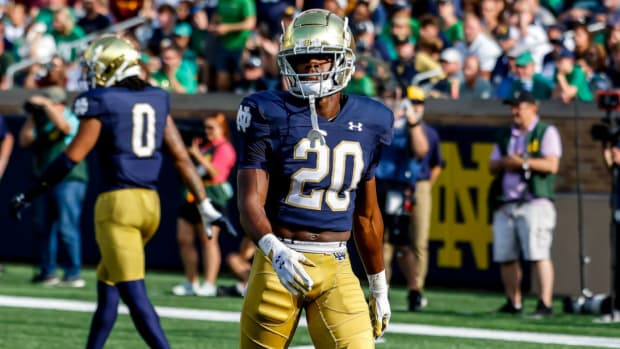Notre Dame Offense Must Be More Aggressive In 2020
Former offensive coordinator Chip Long brought the offense quite a long way in three years. The Irish averaged more points per game and yards per game during the last three seasons than it had during any similar period in Brian Kelly’s ten seasons at Notre Dame.
Notre Dame has gone 33-6 during that stretch, but the goal now is to take the program to the next level. The Irish are just 4-4 against opponents that finished ranked in the Top 15 and 0-3 against opponents that finished ranked in the Top 10, and the offense averaged just 13.0 points per game against those top opponents.
Tommy Rees has replaced Long as the offensive coordinator at Notre Dame, and the expectation for him is that he take the offense to greater heights. Rees returns five starting offensive linemen, a quarterback with a 20-3 career record and a young but talented group of pass catchers.
I have broken down the need for Notre Dame to continue making improvements with its ground game, especially in big games, and the overall need for the pass game to continue improving. But a key ingredient to both is Notre Dame becoming a more aggressive pass offense.
Before I dive into why, take a look at these numbers:
This is a chart of throws that traveled at least 10 yards beyond the line of scrimmage. “Total Att.” Is the percentage of overall throws that traveled this distance, “Att. ITN” are throws of 10-plus yards that were attempted inside the numbers (on the field), “Yards 10+” is the percentage of the quarterback’s total yards were from throws that traveled at least 10 yards, “YPA” is yards per attempt on throws at least 10 yards down the field and “YPC” refers to yards per completion of attempts of at least 10 yards.
There are some interesting numbers here. Quarterback Ian Book’s yards per completion average on throws of at least 10 yards is better than that of Jalen Hurts (Oklahoma), Trevor Lawrence (Clemson) and Justin Fields (Ohio State). He’s very close to Joe Burrow (LSU), with only Tua Tagovailoa (Alabama) having any distance.
The yards per attempt number is lower than desired, but still better than Lawrence and comparable to Fields. Book had the lowest completion percentage on throws of at least 10 yards down the field, and the interesting part of that is he had a better completion percentage on throws of at least 20 yards than he did on throws of at least 10 yards, partly due to a higher number of drops.
The only two significant differences between Book and other top quarterbacks is how frequently - or perhaps a better way to say it is how infrequently - he attempted downfield shots, and him being less willing to attack the middle of the field. The gap is especially wide with every offense except Alabama’s, but that is partly due to Alabama’s high efficiency with intermediate and deep throws.
If you look at the numbers, the 2019 offense was every bit as effective throwing the ball down the field as the 2015 offense that had DeShone Kizer, Malik Zaire, Will Fuller, Chris Brown and Amir Carlisle.
Notre Dame’s 2015 offense averaged 12.4 yards per attempt and 23.1 yards per completion on throws that traveled at least 10 yards past the line. The 2019 offense averaged 12.2 yards per attempt and 24.1 yards per completion.
The difference is the 2015 offense threw at least 10 yards down the field on 44.7-percent of its overall attempts, and 21.9-percent of those throws were between the numbers.
So what does this tell us?
1. Notre Dame Can Hurt Teams Down The Field: I’ve made this case before, but Book’s issues aren’t an inability to throw the ball downfield, it’s a willingness issue. He made huge strides as a senior, completing over 50-percent of his deep throws (20+ yards). When he actually attacks downfield, and does so confidently, Book throws an impressive deep ball.
2. Notre Dame Needs To Be More Aggressive With Its Pass Game: The 2020 offense will have more all-around speed than it did in 2019, so the big-play potential on downfield throws should only increase. What we need to see in 2020 is Rees being more aggressive with his play-calling, and when that happens Book needs to be more willing to take those shots, especially in big games.
3. Notre Dame Must Attack The Middle Of The Field More: Book has often been hesitant to attack the middle of the field, especially on intermediate (10-19 yards) throws. That’s usually a higher risk area for turnovers, and Book goes too far in the direction of avoiding turnovers. Protecting the football is important, but when it causes you to avoid attacking an important part of the field it limits your offense.
I recently broke down specific areas where the pass game can improve, and in that analysis I discuss aspects that will effect the deep game. You can read that HERE.
Being more aggressive with the pass game and attacking the middle of the field more effectively has three major benefits to the offense.
1. Creates A More Explosive Offense: This one is pretty easy to figure out. If Notre Dame can maintain its current level of effectiveness on deep balls but simply takes more downfield shots it will provide a significant impact. You’re talking about adding at least 300 yards to the season totals, but more importantly it would put much greater stress on defenses.
2. Takes Pressure Off The Run Game: If Notre Dame is more willing to take down the field shots and continues its level of effectiveness it will put defenses in a major bind. Do you continue to play an eight-man box and play your safeties in the alleys, which so many teams try to do now a days, or do you play your safeties back and protect against the intermediate and deep throws?
3. It Opens Up More Room To Work In The Screen Game/Perimeter Throws: A more successful vertical game, especially one that is willing to attack the middle of the field at a greater frequency, also opens up the perimeter throwing game and screen game. Teams could widen out their defense to take away Chase Claypool last season because there wasn’t as much of a threat over the middle. It also limited the effectiveness of the RPO game. If Book and Rees are more willing to attack that zone it forces safeties and linebackers to be more aware of it before taking off to the perimeter
Notre Dame should have explosive playmakers on the perimeter this season, and any hesitation they can cause with defenses will open up greater big play opportunities.
If Rees is able to design more ways to attack these zones on the field, and if he's able to get Book to be more willing (and able) to attack these zones the Irish offense could see a significant jump in explosiveness, production and scoring.






